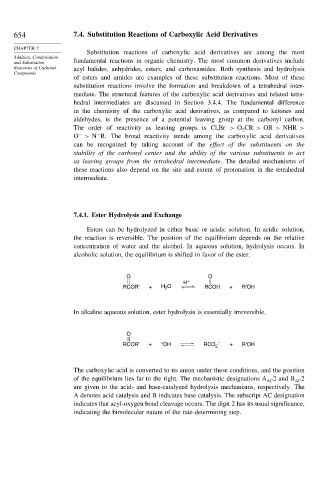Page 672 - Advanced Organic Chemistry Part A - Structure and Mechanisms, 5th ed (2007) - Carey _ Sundberg
P. 672
654 7.4. Substitution Reactions of Carboxylic Acid Derivatives
CHAPTER 7
Substitution reactions of carboxylic acid derivatives are among the most
Addition, Condensation
and Substitution fundamental reactions in organic chemistry. The most common derivatives include
Reactions of Carbonyl acyl halides, anhydrides, esters, and carboxamides. Both synthesis and hydrolysis
Compounds
of esters and amides are examples of these substitution reactions. Most of these
substitution reactions involve the formation and breakdown of a tetrahedral inter-
mediate. The structural features of the carboxylic acid derivatives and related tetra-
hedral intermediates are discussed in Section 3.4.4. The fundamental difference
in the chemistry of the carboxylic acid derivatives, as compared to ketones and
aldehydes, is the presence of a potential leaving group at the carbonyl carbon.
The order of reactivity as leaving groups is Cl,Br > O CR > OR > NHR >
2
−
−
O > N R. The broad reactivity trends among the carboxylic acid derivatives
can be recognized by taking account of the effect of the substituents on the
stability of the carbonyl center and the ability of the various substituents to act
as leaving groups from the tetrahedral intermediate. The detailed mechanisms of
these reactions also depend on the site and extent of protonation in the tetrahedral
intermediate.
7.4.1. Ester Hydrolysis and Exchange
Esters can be hydrolyzed in either basic or acidic solution. In acidic solution,
the reaction is reversible. The position of the equilibrium depends on the relative
concentration of water and the alcohol. In aqueous solution, hydrolysis occurs. In
alcoholic solution, the equilibrium is shifted in favor of the ester.
O O
H +
RCOR' + H O RCOH + R'OH
2
In alkaline aqueous solution, ester hydrolysis is essentially irreversible.
O
RCOR' + – OH RCO 2 – + R'OH
The carboxylic acid is converted to its anion under these conditions, and the position
of the equilibrium lies far to the right. The mechanistic designations A 2 and B 2
AC
AC
are given to the acid- and base-catalyzed hydrolysis mechanisms, respectively. The
A denotes acid catalysis and B indicates base catalysis. The subscript AC designation
indicates that acyl-oxygen bond cleavage occurs. The digit 2 has its usual significance,
indicating the bimolecular nature of the rate-determining step.

